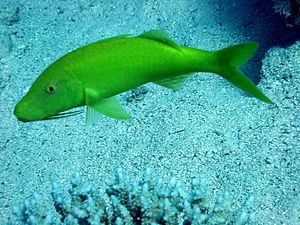Gold-saddle goatfish facts for kids
Quick facts for kids Gold-saddle goatfish |
|
|---|---|
 |
|
| Conservation status | |
| Scientific classification | |
| Genus: |
Parupeneus
|
| Species: |
cyclostomus
|
| Synonyms | |
|
See text |
|
The Parupeneus cyclostomus, also known as the gold-saddle goatfish, blue goatfish, or yellowsaddle goatfish, is a type of goatfish. These fish live in the Indo-Pacific Ocean. People often catch them for food, and they are also popular for sport fishing. Sometimes, these fish can carry a natural toxin called ciguatera that can make people sick if they eat them. You might also see them in aquariums.
What Does It Look Like?
This fish usually has a yellow body with a bit of a bluish shine on its back. However, some of them are completely golden yellow! The gold-saddle goatfish can grow up to 50 cm (20 in) long, which is about the length of a large ruler. Most of them are a bit smaller, usually around 35 cm (14 in).
Where Does It Live?
You can find the gold-saddle goatfish swimming alone or in small groups. They live in many parts of the coral reefs and on sandy or rocky bottoms. They can be found in waters from 1 meter (about 3 feet) deep all the way down to 95 meters (about 310 feet) deep.
This fish has special whisker-like feelers called barbels under its chin. It uses these barbels to poke into holes and cracks in the reef. This helps them find and force out small creatures hiding there, which they then eat.
You can find these fish across a huge area, from the Red Sea near Africa, all the way to South Africa. They also live near the Hawaiian Islands and the Ryukyu Islands in Japan.
Images for kids
-
Yellow variant, Gulf of Aqaba, Red Sea
See also
 In Spanish: Parupeneus cyclostomus para niños
In Spanish: Parupeneus cyclostomus para niños



